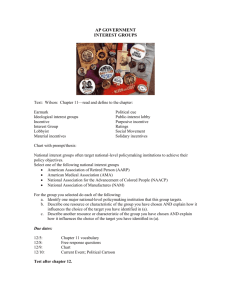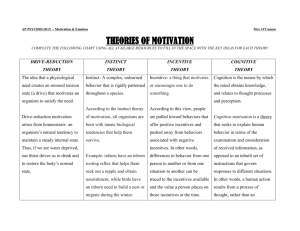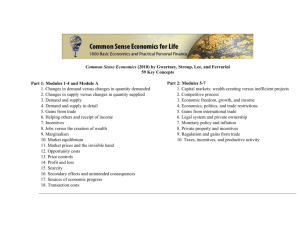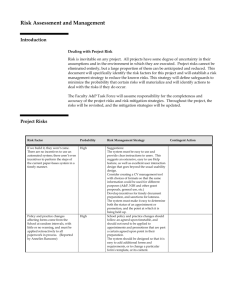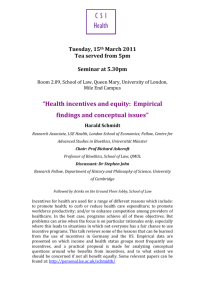Community Tool Box - Providing Incentives for Staff and Volunteers
advertisement
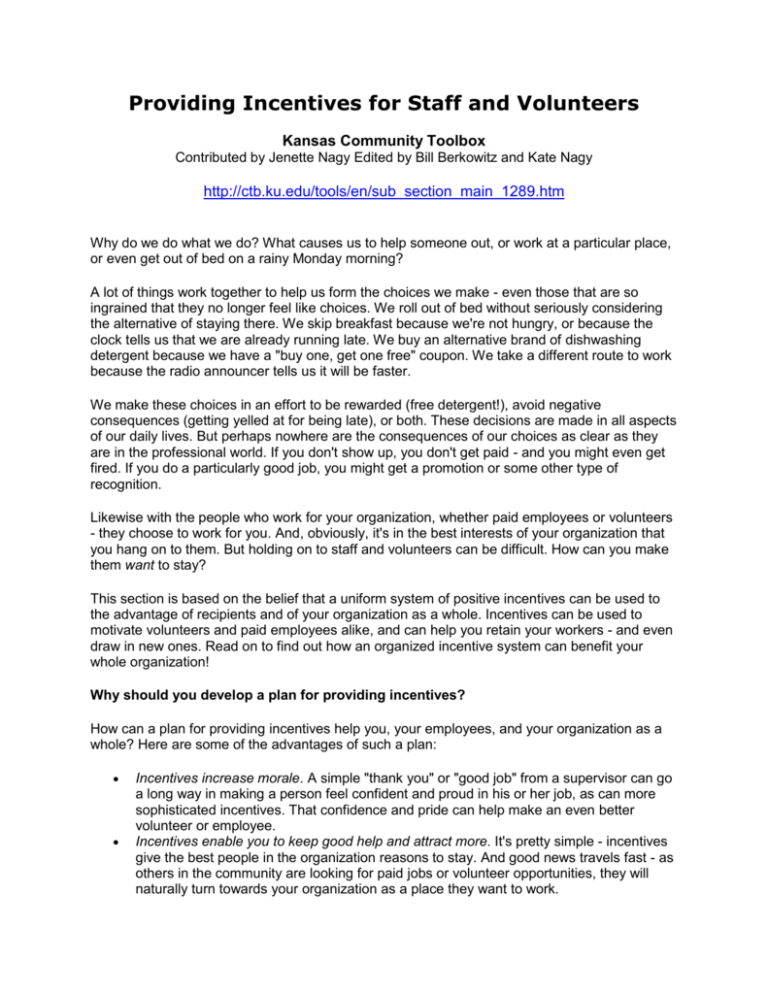
Providing Incentives for Staff and Volunteers Kansas Community Toolbox Contributed by Jenette Nagy Edited by Bill Berkowitz and Kate Nagy http://ctb.ku.edu/tools/en/sub_section_main_1289.htm Why do we do what we do? What causes us to help someone out, or work at a particular place, or even get out of bed on a rainy Monday morning? A lot of things work together to help us form the choices we make - even those that are so ingrained that they no longer feel like choices. We roll out of bed without seriously considering the alternative of staying there. We skip breakfast because we're not hungry, or because the clock tells us that we are already running late. We buy an alternative brand of dishwashing detergent because we have a "buy one, get one free" coupon. We take a different route to work because the radio announcer tells us it will be faster. We make these choices in an effort to be rewarded (free detergent!), avoid negative consequences (getting yelled at for being late), or both. These decisions are made in all aspects of our daily lives. But perhaps nowhere are the consequences of our choices as clear as they are in the professional world. If you don't show up, you don't get paid - and you might even get fired. If you do a particularly good job, you might get a promotion or some other type of recognition. Likewise with the people who work for your organization, whether paid employees or volunteers - they choose to work for you. And, obviously, it's in the best interests of your organization that you hang on to them. But holding on to staff and volunteers can be difficult. How can you make them want to stay? This section is based on the belief that a uniform system of positive incentives can be used to the advantage of recipients and of your organization as a whole. Incentives can be used to motivate volunteers and paid employees alike, and can help you retain your workers - and even draw in new ones. Read on to find out how an organized incentive system can benefit your whole organization! Why should you develop a plan for providing incentives? How can a plan for providing incentives help you, your employees, and your organization as a whole? Here are some of the advantages of such a plan: Incentives increase morale. A simple "thank you" or "good job" from a supervisor can go a long way in making a person feel confident and proud in his or her job, as can more sophisticated incentives. That confidence and pride can help make an even better volunteer or employee. Incentives enable you to keep good help and attract more. It's pretty simple - incentives give the best people in the organization reasons to stay. And good news travels fast - as others in the community are looking for paid jobs or volunteer opportunities, they will naturally turn towards your organization as a place they want to work. Incentives increase the productivity (or safety, or anything else you wish to promote) of members of your organization. If it is understood that increased productivity, or a decrease in accidents, or longevity as a member of the organization gets fairly (or even handsomely) rewarded, then people will do their best to be productive and safe, or to remain with the organization. Bottom line? Things that are rewarded get done. These are all good reasons for giving incentives in general. A final thought pertaining to developing a plan or program that discusses how incentives will be carried out : An incentive program can decrease real and perceived favoritism by rewarding employees equally for actions or longevity. Jealousy or envy can deeply harm an organization, and are sure to spring up when employees are rewarded unequally. When should you provide incentives? So if you have decided to provide incentives for your staff and volunteers, when should you do so? This will depend greatly on your organization, but two general rules apply: Reward staff - paid and volunteer - at certain clearly defined milestones. For example, your organization might reward people after a certain amount of time with the organization (after 3, 5, 10, 15, 20, 25 years); at the end of a difficult project; when a challenging goal has been met; or after the successful completion of a training session. Reward regularly and promptly. Whatever events you have decided to celebrate, don't wait six months after a goal has been met to congratulate someone. Rewards and incentives should be given as soon as possible upon reaching a goal. If you wait until six months after the grant has been won to have the party, you will have lost much of the momentum and excitement. Examples of primarily material incentives Pay Straight pay Promotions (with higher pay) Raises (with or without promotion) Merit pay Bonus pay (for performance, attendance, or other action) Incentive pay Profit sharing (including stock options) Indirect pay (e.g., gift certificates) Contests (one-time pay) Randomly determined pay (e.g., drawings, lotteries) Benefits Standard benefits packages, such as vacation time, health insurance, et cetera Hiring into a paid staff position (for volunteers) Extra vacation days Perks (better office locations or parking spaces; coffee, juice and doughnuts at the Monday morning meeting) Sick leave buybacks Tuition, training, or other educational reimbursements Flex time - Allowing employees to choose their hours (to the extent possible) can be a huge incentive to busy people, such as those with young children or those working two or more jobs. Release time for various functions, possibly including service work - It's becoming more and more common for employers to give their employees time (on the clock) to take part in other community volunteer opportunities (such as mentoring, coaching, working at the local homeless shelter, et cetera). Examples of less material or nonmaterial incentives Praise - This can take place in person, both verbally and nonverbally (for example, a thumbs up at the end of a presentation), or in the form of a letter (even an e -mail) congratulating someone on their outstanding work. Honors, such as naming someone employee or volunteer of the month/year, or nominating them for honors outside of the organization Awards and prizes, such as plaques, pins, certificates, clothing with the organization's name, mugs, et cetera. There are entire magazines dedicated to this type of award (see Resources). Banquets, potlucks, and picnics Training - This can be a very powerful incentive for people who hope to gain useful skills or certification from their work with your organization. Public recognition, in the form of a feature article about the person and their work in the organization's newsletter or in the local press Staff outings/retreats - These can serve as an excellent opportunity for people to reflect together on the work they are doing, and reaffirm their commitment to the work and to each other. Social events - From planned celebrations to casual drinks after work, these can do a lot to make coworkers more comfortable where they work. In doing so, productivity may increase (as coworkers are more comfortable working together on projects and suggesting their ideas), and a comfortable working atmosphere may convince people to keep their jobs longer as well. Remember: people may work on ideas and projects, but they work with other people. Increased autonomy- Allowing people to be self-directed and free from constant scrutiny shows confidence in an employee or volunteer and his/her abilities to do a job well. Networking opportunities - Finally, give people the opportunity to meet others and thus grow professionally. This can happen through conferences or by introducing people to others who can be helpful to them personally or professionally. Additional information on: How do you design and implement an incentive plan? Sustaining the incentive program


